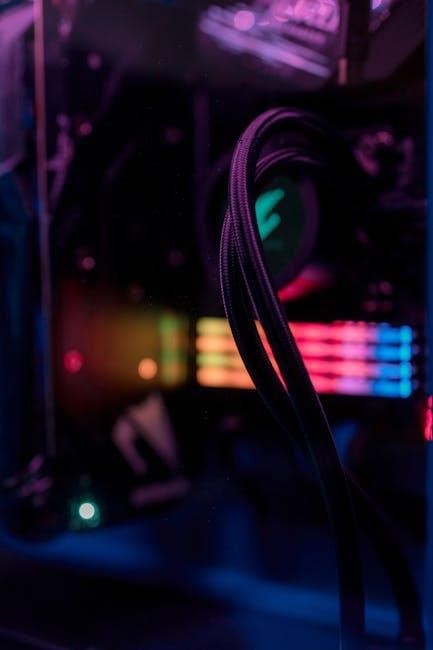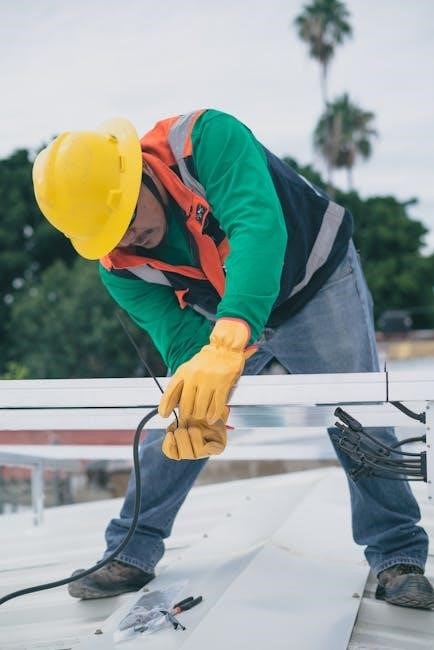Understanding your Trane thermostat wiring is essential for efficient HVAC system operation. This guide provides a comprehensive overview of wiring diagrams, safety tips, and installation steps. Whether you’re a homeowner or technician, this resource will help you navigate the complexities of modern thermostat systems with confidence. By following the detailed instructions, you’ll ensure proper connections, optimal performance, and enhanced comfort. Start your journey to mastering Trane thermostat wiring with this invaluable guide.

Understanding Trane Thermostat Wiring Diagrams
Trane thermostat wiring diagrams are essential for installing and troubleshooting systems. They provide detailed layouts for 230V and 460V systems, covering single-stage, multistage, and heat pump configurations. These diagrams ensure proper connections between thermostats, HVAC units, and electrical components, helping technicians and homeowners avoid errors. Always refer to the specific diagram for your system to guarantee safe and accurate wiring.
Single-Stage Systems
Single-stage HVAC systems operate with a single level of heating and cooling, making their wiring relatively straightforward. Trane thermostat wiring diagrams for these systems typically involve connecting basic wires like R (24VAC power), W (heating), Y (cooling), G (fan), and C (common). These systems are ideal for simpler setups and are commonly used in smaller homes or environments with consistent temperature needs. The wiring process ensures that the thermostat can control the HVAC unit efficiently. Proper connections are crucial to avoid malfunctions and ensure optimal performance. Always follow the specific diagram provided for your Trane model to guarantee accurate setup and operation.
Multistage and Heat Pump Systems
Multistage and heat pump systems require more complex wiring due to their advanced functionality. These systems utilize multiple stages of heating and cooling, which demand precise wiring configurations to ensure proper operation. For Trane heat pumps, the wiring diagram typically includes additional terminals such as O/B (reversing valve) and Y1/Y2 (multiple cooling stages). The R, W, Y, G, and C wires are still essential, but their connections may vary depending on the system’s capabilities. It’s crucial to use 18-gauge color-coded thermostat cable for these setups, as specified in the guidelines. Shielded cable may be necessary to prevent interference, especially in systems with advanced features. Always refer to the specific Trane wiring diagram for your model, as heat pumps and multistage systems often require unique connections. Proper wiring ensures efficient performance and avoids potential malfunctions. Adhere to the manufacturer’s instructions carefully for a safe and effective installation.

Essential Tools and Materials Needed
Before starting your Trane thermostat wiring project, ensure you have the right tools and materials. You’ll need an 18-gauge color-coded thermostat cable, which is the standard for proper wiring. A screwdriver set, including Phillips and flathead, will be essential for connecting wires to terminals. Wire strippers are necessary for safely removing insulation from wire ends. A voltage tester is crucial for verifying power levels and ensuring safety. Pliers and needle-nose pliers can help with tight spaces and precise connections. A ladder or step stool may be required for accessing the thermostat or HVAC unit. Finally, refer to the Trane wiring diagram specific to your system for guidance. Always use shielded cable if recommended by the manufacturer to prevent interference. Gather these tools and materials beforehand to ensure a smooth and efficient installation process. Proper preparation is key to avoiding errors and ensuring system reliability.

Step-by-Step Installation Guide
Power off your HVAC system before starting. Locate the terminal block and connect wires according to the Trane wiring diagram. Match each wire to its corresponding terminal (R, G, Y, W, C). Use 18-gauge color-coded cable for proper connections. Secure all wires firmly and double-check the diagram to ensure accuracy. Turn the power back on and test the system to confirm everything works correctly. Follow these steps carefully for a successful installation.
Preparing for Installation
Before starting, ensure the HVAC system is powered off at the circuit breaker. Gather essential tools like wire strippers, screwdrivers, and pliers. Review the Trane wiring diagram specific to your system to understand the connections. Use 18-gauge color-coded thermostat cable for reliability. Keep wires at least one foot away from large electrical components to avoid interference. Shielded cable may be necessary if wiring guidelines aren’t met. Ground all unused wires at the indoor unit chassis for safety. Ensure the thermostat base is leveled for proper installation, though leveling doesn’t affect operation. Familiarize yourself with the terminal block and label wires if needed. Double-check local electrical codes and manufacturer instructions. Proper preparation ensures a smooth and safe installation process, reducing the risk of errors and potential system malfunctions. Take your time to organize materials and plan connections carefully.
Connecting the Wires
Refer to the Trane wiring diagram for your specific system to identify each wire’s purpose. Match the wires to their corresponding terminals on the thermostat and HVAC unit. Use screwdrivers to secure the wires tightly. Ensure the common (C) wire is properly connected for continuous power. For heat pumps, verify the reversing valve wiring (O/B) is correctly set. Use wire nuts or connectors for secure joints. Label wires if necessary to avoid confusion. Keep wires organized to prevent tangles or damage. Follow manufacturer guidelines for terminal connections. Double-check all wires before restoring power. If unsure, consult a professional to avoid system damage or safety risks. Proper wire connections are crucial for optimal system performance and safety.
Troubleshooting Common Wiring Issues
If your Trane thermostat isn’t functioning correctly, wiring issues may be the culprit. Start by ensuring all connections are secure and free from corrosion. Verify that the common wire (C) is properly connected to maintain power. If the thermostat lacks power, check your circuit breaker or fuse box. For unresponsive thermostats, inspect for loose or misconnected wires, referencing your wiring diagram. Short circuits can occur if wires touch unintended surfaces; insulate any exposed wires. If the system fails to heat or cool, check stage wiring (W1, W2) for multistage systems. Ensure the reversing valve (O/B) is correctly configured for heat pumps. Addressing these issues promptly can restore functionality and prevent further complications. Always prioritize safety and consult a professional if unsure.
Safety Precautions and Best Practices
When working with your Trane thermostat wiring, prioritize safety to avoid electrical hazards. Always turn off the power to the HVAC system at the circuit breaker before starting any work. Verify the power is off using a voltage tester. Wear protective gear, such as insulated gloves, to prevent shocks. Ensure all wires are properly insulated and kept away from open flames or sparks. Avoid overloading circuits, as this can cause fires. Use 18-gauge color-coded thermostat cable for reliable connections, and keep wiring at least one foot away from large appliances to reduce interference. Ground unused wires at the indoor unit chassis to prevent electrical issues. If unsure about any step, consult a licensed electrician. Regularly inspect wires for damage or wear, and replace them as needed. Following these guidelines ensures a safe and efficient installation or repair process.

Frequently Asked Questions
Q: What type of wire should I use for my Trane thermostat?
A: Use 18-gauge color-coded thermostat cable for proper connections. Shielded cable may be required if wiring is near large appliances or electrical interference sources.
Q: Why is grounding important?
A: Grounding unused wires at the indoor unit chassis prevents electrical issues and ensures safe operation. Always follow manufacturer guidelines.
Q: Can I reuse old wiring?
A: Inspect old wires for damage or wear. If damaged, replace them to avoid malfunctions. Proper insulation is crucial for safety and efficiency.
Q: How far should wires be from large appliances?
A: Keep wires at least one foot away from large appliances to minimize electrical interference and ensure reliable performance.
Q: What if I encounter wiring issues?
A: Refer to the wiring diagram or consult a licensed electrician if unsure. Regular inspections can prevent potential problems.
Mastering the Trane thermostat wiring process ensures efficient and safe operation of your HVAC system. By following the guidelines outlined in this guide, you can confidently navigate wiring diagrams, troubleshoot common issues, and perform installations with precision. Always prioritize safety, using the correct tools and materials to avoid electrical hazards. Regular inspections and adherence to best practices will extend the lifespan of your system and maintain optimal performance. Whether you’re a homeowner or a technician, this guide serves as a valuable resource for understanding and working with Trane thermostats. Remember to reference wiring diagrams and manufacturer instructions for specific models, and never hesitate to seek professional help if unsure. With proper wiring and maintenance, your Trane thermostat will provide reliable comfort and efficiency for years to come.
